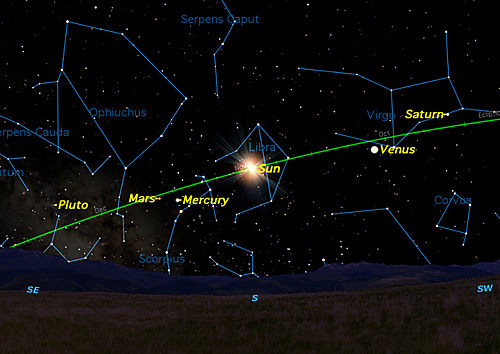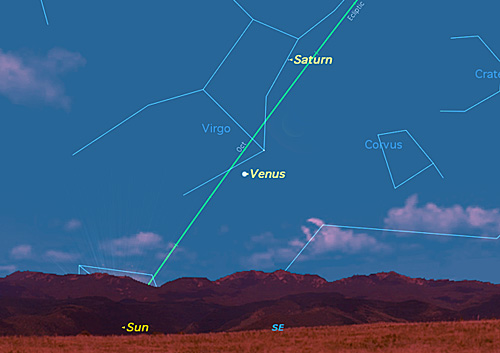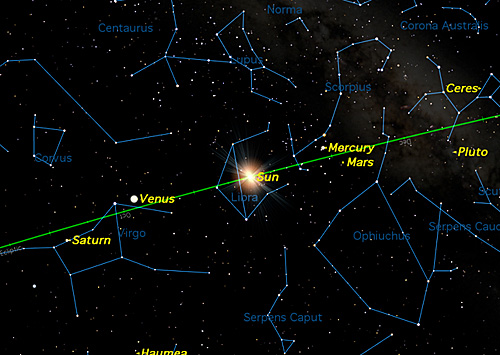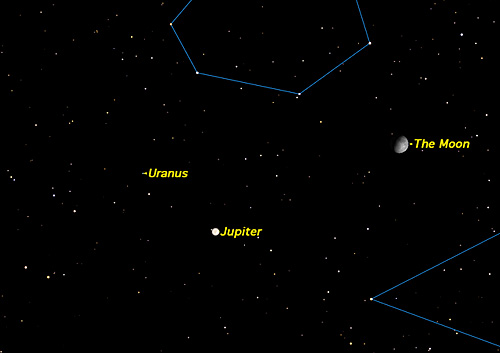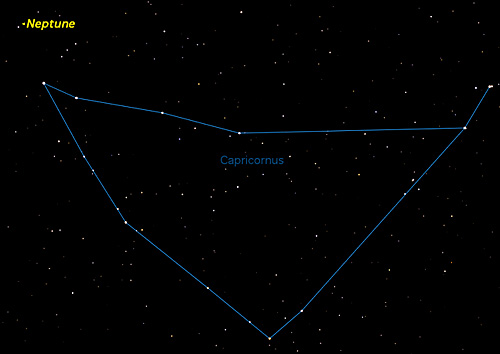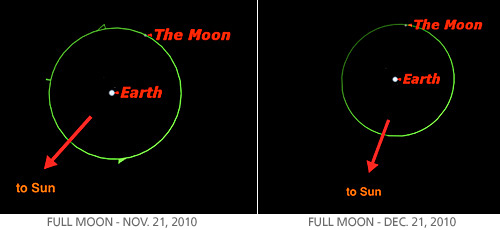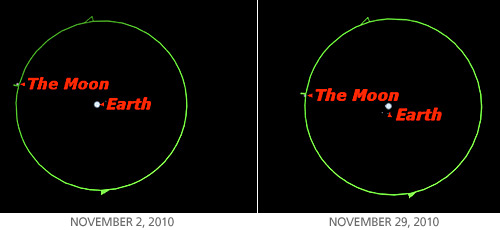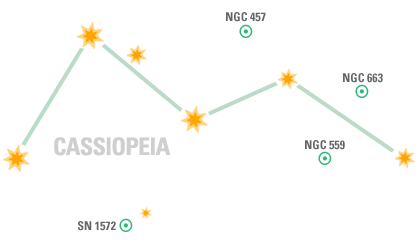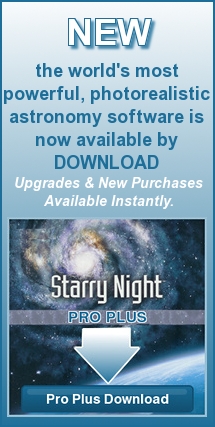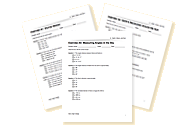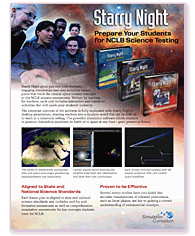 |
||||||||||||||||||||||||||||||||||||||||||||||||||||||||||||||||||||||||||||||||||||||||||||||||||||||||||||||||||||
|
If you have trouble viewing this newsletter, click here. Welcome again to our monthly newsletter with features on exciting celestial events, product reviews, tips & tricks, and a monthly sky calendar. We hope you enjoy it!
How many planets can you see during one night? Starry Night can help you find out, and guide you towards finding them. The most difficult planets are those closest to the Sun, since the Sun’s light blocks our view. However, with Starry Night it’s easy to see the planets and stars around the Sun. All you need to do is go to the View menu and choose Hide Daylight. To make more sense of what we’re seeing, let’s turn on the labels for the planets (under the Labels menu), the astronomical constellation figures and labels (under the View menu), and the ecliptic (in the Options pane under Guides:Ecliptic Guides). To make things easier, here is a file with all the settings made for you <planets.snf>.
This kind of image tells us a lot. On the date in question, 2010 November 15, the Sun is smack in the middle of Libra. This tells us that we won’t be able to see Libra, or much of the constellations immediately next to Libra. This view is from my backyard in central Canada. It shows that I will have a lot of trouble seeing Mercury or Mars. Not only are they close to the Sun, but they are also well below the Sun in declination. Venus and Saturn, on the other hand, are a but farther from the Sun and are higher in declination, so are much more likely to be visible when the Sun is just below the horizon, in the early morning. Change the time to sunrise and turn daylight back on, and you’ll see a fine sight.
But how do people on the other side of the world see the planets? Use Starry Night’s Viewing Location to move to Melbourne, Australia:
G’day, mate! Everything’s upside-down and topsy-turvy! Now Mercury and Mars are higher in the sky, and Venus and Saturn are lower. This means that, from Melbourne, Mercury and Mars will be relatively well placed in the evening sky while Venus and Saturn will be more difficult to see in the morning sky. By adjusting time, date, and location in Starry Night you can explore all sorts of scenarios on the visibility of the planets—go ahead, do it! But the bottom line for each of us is what we can see from our particular location on the planet Earth. [You can visit other planets, even other stars in Starry Night, but that’s another story.] The chart we started with tells us that, at least in mid-November, Mars and Mercury are probably impossible to see from my backyard. Advance time in Starry Night, and they’ll eventually become better placed. Starry Night will tell us exactly when. It also tells us that Venus and Saturn are now well placed in the morning sky, just before sunrise. To add to the good news, if you select Saturn by double clicking on it and zoom in, you’ll see that its famous rings are now opening up nicely, having been almost invisible for the past two years. What of the other planets? I’ve left them until the last because they are the easiest. Go out any night this month and you’ll see Jupiter blazing forth, the brightest object in the night sky. The planet Uranus is very close to it. Use Starry Night to make a finder chart, like this one for November 15:
Unless you have very sharp eyes and a very dark sky, you will need binoculars to spot it. Finally, the farthest of the planets, Neptune. It also will require binoculars, but is quite easy to locate at the eastern tip of the triangular constellation Capricornus:
So, next clear night, how many of these planets can you locate? Geoff Gaherty
About once a month, the Moon goes through its predictable cycle of phases: from Full Moon to New Moon and back to Full Moon again. It is not surprising then that the Moon has been used to measure time since antiquity. Thus the “month” became closely tied to the motion of our celestial neighbor. But as early astronomers studied the lunar cycle, it became clear that there was more than one way to define a month. The most obvious “month” was the time from Full Moon to the next Full Moon which is approximately 29.5 days. This is the synodic month and it depends on the Moon’s position relative to the Sun. A Synodic Month
The sidereal month, on the other hand, is the period of revolution of the Moon relative to the stars. The Moon’s phase, however, is not the same because only 27.3 days have elapsed. After one sidereal month, the Moon has returned almost to the same position in its orbit as the graphics below illustrate. A Sidereal Month
If we measure the time between two successive perigee passages, we define an anomalistic month. This month is slightly longer than the sidereal month because the Moon’s orbit rotates with a period of about 9 years. Here is a summary of the average lengths of the three months we examined:
You may also wish to investigate the meaning of tropical month and draconic month. Further Study What could cause the anomalistic month to be longer than the sidereal month? Answer to last month’s question: The Moon passes through perigee approximately every 27.3 days. Because it is then closer to the Earth there should be a greater tidal effect. Herb Koeller
Sirius and Dog Days of Summer Press the "Run time forward" button to watch the Dog Star, Sirius, rise at the same time as the Sun on July 4, 3000 BC in Cairo, Egypt. The ancients believed that the simultaneous rising of the Sun with the brightest star in the sky, Sirius, marked the beginning of the hottest days of the year. They believed the extra heat was due to the extra energy of Sirius added to the Sun. This is where the term "Dog Days of Summer" originated, a term we still use today! Pedro Braganca
Cassiopeia is one of the easiest constellations to spot during the autumn and winter months; its big "W" shape rotates overhead each night. Apart from being a generally pretty area to scan in binoculars, there are some terrific sights to pick out. 9,000 light years away sits NGC 457, a 6th-mag open cluster known as the Owl Cluster. NGC 559 a 9.5-mag open cluster is about 2.5° from NGC 663 a 7th-mag open cluster seen in binoculars. Cassiopeia is also the area of sky where Tycho's Supernova of 1572 appeared slightly to the west of Kappa Cassiopeiae, changing the appearance of the sky for six months and cementing Copernicus' 1543 rebuttal of Ptolemaic theory; in that year Copernicus died and his great work De revolutionibus orbium coelestium was published, overturning the established doctrine that the Earth was at the center of the universe. Unfortunately, nothing is visible to amateur astronomers but the site is of obvious historic interest. Sean O'Dwyer
|
NOV 2010
|
|||||||||||||||||||||||||||||||||||||||||||||||||||||||||||||||||||||||||||||||||||||||||||||||||||||||||||||||||||

|
||||||||||||||||||||||||||||||||||||||||||||||||||||||||||||||||||||||||||||||||||||||||||||||||||||||||||||||||||||
|
|
||||||||||||||||||||||||||||||||||||||||||||||||||||||||||||||||||||||||||||||||||||||||||||||||||||||||||||||||||||
You have received this e-mail as a user of Starry Night® or as a registrant at starrynighteducation.com
To unsubscribe, click here.

 EDUCATION ORDERS 1-877-290-8256
EDUCATION ORDERS 1-877-290-8256